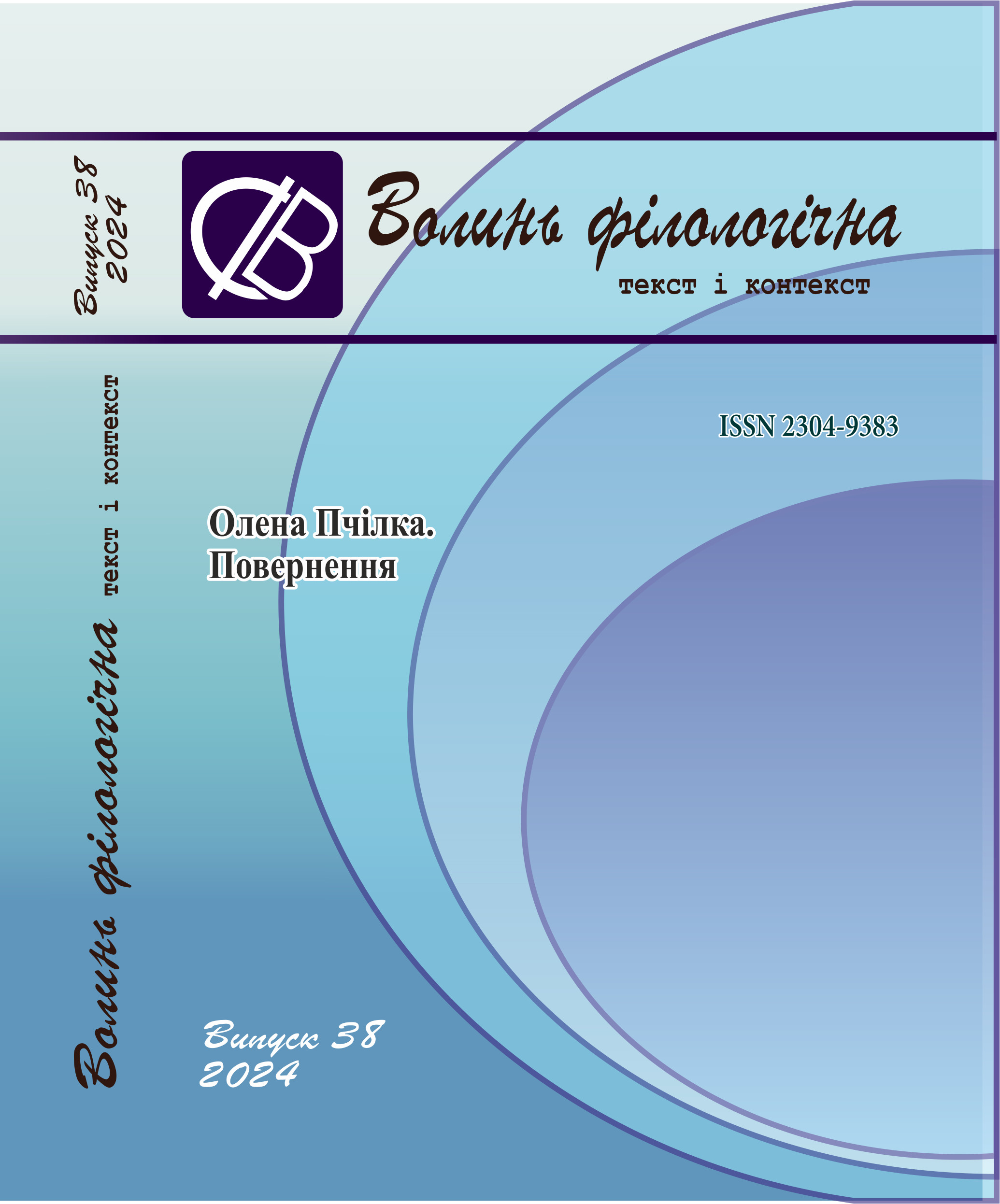Olena Pchilka’s “Comrades” (“Tovaryshki”) and LesyaUkrainka’s “Friendliness” (“Pryiazn”) as a “Girl’s Text”
DOI:
https://doi.org/10.29038/2304-9383.2024-38.oksKeywords:
“girl’s text,” discourse of “girl’s text,” liminality, the transition ritual, masculine / feminine initiation, girl’s growing up, gender stereotype, psychologism, children’s and youth literature, women’s literatureAbstract
The reasons for the relevance of the article are as follows: 1) “girl’s text” is one of the terms that are at the stage of entering the literary studies space and do not have a clear terminological definition; 2) at the
theoretical level, “girl’s text” is not characterized thoroughly enough: its separate formal and semantic features are outlined, but its philosophical and aesthetic basis is not defined; 3) the discourse of “girl’s text” in Ukrainian literature is far from being comprehended holistically,
in particular, the texts of the nineteenth and early twentieth centuries are on the literary
periphery. Among them are Olena Pchilka’s “Comrades” (“Tovaryshki”) (1887) and Lesya
Ukrainka’s “Friendliness” (“Pryiazn”) (1905), which became the material of our research.
The objective of this two-part article is to define the term and phenomenon of the “girl’s text” and to analyze Olena Pchilka’s “Comrades” and Lesya Ukrainka’s “Friendliness” as works that reveal the specifics of the early stages of “girl’s text” discourse in Ukrainian literature.
Methods and techniques. To achieve the objective, the main methodological tools of
the theory of liminality were used, in particular, the literary analysis method proposed by Zhanna Bortnik. Comparative (typological and comparative, genetic-contact, thematological, and herpetological) literary analysis methods are used. Elements of stylistic, cultural-historical, biographical, and psychoanalytic methods are used.
Scientific novelty. For the first time, the article defines the philosophical and aesthetic basis of the “girl’s text” – the theory of liminality – the ritual of transition in its masculine and feminine variations. The former is based on the masculine theory of liminality, formed by Arnold van Gennep and Victor Turner (separation-liminality- incorporation), and the latter on its feminine variant, expressed by Bruce Lincoln and Catherine Bell (enclosure-metamorphosis-semergence).
The results of the research. In the process of analyzing the novels “Comrades” by
Olena Pchilka and “Friendliness” by Lesya Ukrainka as “girl’s texts,” the necessity of using liminality as a literary methodology is proved. Two models of the“girl’s text” are presented: masculine (Olena Pchilka’s “Comrades”) and feminine (Lesya Ukrainka’s “Friendliness”). The initial stages of the discourse of the “girl’s text” are characterized: Olena Pchilka’s work
reflects the stage of the active phase of the struggle for gender equality in society,
Lesya Ukrainka’s work was born in the crucible of deep comprehension of the specifics of female psychology, in particular the traumatized girl’s psyche. It is proved that the Ukrainian “girl’s text” of the nineteenth and early twentieth centuries fits into the context of the specifics of the origin, formation, and development of the “girl’s text” in the world literary process (Western European and Ukrainian).
Conclusions. The “girl’s text” is a gendered modification of the “educational novel”
as a text capable of being realized in various genre forms (short story, novella, novel, etc.) in the process of plot disclosure based on the matrix of the ritual of transition – the stages of a girl’s growing up. The “girl’s text,” having a philosophical and aesthetic basis and a stable formal and semantic framework, can adapt to worldview and aesthetic changes and “survive” in different stylistic paradigms. At the initial stages of its formation, the “girl’s text” evolved in the stylistic aspect from realism (Olena Pchilka’s “Comrades”) to neorealism (Lesya Ukrainka’s “Friendliness”)
References
Бортник, Ж. (2023). Концепція лімінальності в літературознавчій парадигмі:
проєкція на сучасну українську драму. Автореф. дис. д-ра філол. наук,
Волинський національний університет імені Лесі Українки. Луцьк.
Качак, Т. (2017). «Дівчачі тексти»: фемінний дискурс у сучасній українській
прозі для юних читачів. Слово і Час, 4, 79–90.
Кизилова, В. (2013). «Повість для дівчаток» у літературі для дітей та юнацтва ІІ
пол. ХХ – поч. ХХІ століття: специфіка моделювання образів. Слово і Час,
5, 70 – 76.
Пчілка, Олена. (1988). Твори. Київ: Дніпро.
Українка, Леся. (2021). Повне академічне зібрання творів (Т. 1–14). Луцьк:
Волинський національний університет імені Лесі Українки.
Улюра, Г. (2020, 7 квітня). Дівчача проза, яка (не) пройшла випробування часом.
Суспільне. Культура. URL: https://suspilne.media/22130-divcaca-proza-aka-
ne-projsla-viprobuvanna-casom/
Улюра, Г. (2020). Ніч на Венері: 113 письменниць, які сяють у темряві. Київ:
ArtHuss.
Bell, C. (1997). Ritual. Perspectives and Dimensions. Oxford, N.Y.
Gennep, A. Van. (1960). The Rites of Passage. Chicago: University of Chicago Press.
Lincoln, B. (1981). Emerging from the Chrysalis: Rituals of Women’s Initiations.
Cambridge, Mass.: Harvard University Press.
Turner, V. (1977). The Ritual Process: Structure and Anti-Structure. Ithaca, New
York: Cornell Paperbacks Cornell University Press.

